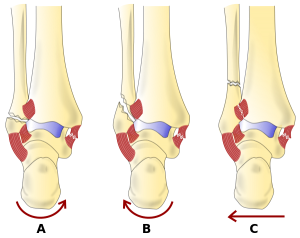Danis-Weber Classification of Ankle Fractures: Difference between revisions
Kim Jackson (talk | contribs) No edit summary |
Kim Jackson (talk | contribs) (Include references) |
||
| Line 9: | Line 9: | ||
Type A - describes a fracture of the lateral malleolus distal to the syndesmosis (the connection between the distal ends of the tibia and fibula). Usually stable: but sometimes in need of an open reduction and internal fixation (ORIF) especially if the medial malleolus is fractured. Typical features : | Type A - describes a fracture of the lateral malleolus distal to the syndesmosis (the connection between the distal ends of the tibia and fibula). Usually stable: but sometimes in need of an open reduction and internal fixation (ORIF) especially if the medial malleolus is fractured. Typical features : | ||
* Below the level of the tibial plafond (syndesmosis) | |||
* Tibiofibular syndesmosis intact | |||
* Deltoid ligament intact | |||
Occasional oblique or | * Occasional oblique or vertical medial malleolus fracture | ||
Type B - describes a fracture at the level of the tibial plafond (syndesmosis). Fracture of the fibula at the level of the syndesmosis. Variable stability. Typical features: | |||
Type B - describes a fracture at the level of the tibial plafond (syndesmosis) | * At the level of the ankle joint, extending proximally in an oblique fashion up the fibula | ||
Fracture of the fibula at the level of the syndesmosis. Variable stability. Typical features: | * Tibiofibular syndesmosis intact or only partially torn, but no widening of the distal tibiofibular articulation | ||
* Medial malleolus may be fractured or deltoid ligament may be torn | |||
Type C - describes a fracture proximal to the level of the tibial plafond and often have an associated syndesmotic injury. Unstable requiring ORIF.<ref>Goost H et al. Fractures of the Ankle Joint: Investigation and Treatment Options. Dtsch Arztebl Int. 2014; 111(21): 377-388.fckLRhttp://www.ncbi.nlm.nih.gov/pmc/articles/PMC4075279/</ref><ref>Jason P. Tartaglione et al. Classifications in Brief: Lauge-Hansen Classification of Ankle Fractures. Clin Orthop Relat Res (2015) 473:3323–3328</ref> Typical features: | |||
* Above the level of the ankle joint | |||
* Tibiofibular syndesmosis injured with widening of the distal tibiofibular articulation | |||
Type C - describes a fracture proximal to the level of the tibial plafond and often have an associated syndesmotic injury. Unstable requiring ORIF. | * Medial malleolus fracture or deltoid ligament injury may be present. | ||
==Conclusion== | ==Conclusion== | ||
Revision as of 21:36, 17 February 2019
Original Editor - Kim Jackson
Top Contributors - Kim Jackson and Tolulope Adeniji
Introduction[edit | edit source]
The Danis-Weber classification is a method of describing ankle fractures and is based on radiographic criteria. It takes into consideration the position of the distal fibular fracture in relation to the syndesmosis of the ankle joint. The three categories are:
Type A - describes a fracture of the lateral malleolus distal to the syndesmosis (the connection between the distal ends of the tibia and fibula). Usually stable: but sometimes in need of an open reduction and internal fixation (ORIF) especially if the medial malleolus is fractured. Typical features :
- Below the level of the tibial plafond (syndesmosis)
- Tibiofibular syndesmosis intact
- Deltoid ligament intact
- Occasional oblique or vertical medial malleolus fracture
Type B - describes a fracture at the level of the tibial plafond (syndesmosis). Fracture of the fibula at the level of the syndesmosis. Variable stability. Typical features:
- At the level of the ankle joint, extending proximally in an oblique fashion up the fibula
- Tibiofibular syndesmosis intact or only partially torn, but no widening of the distal tibiofibular articulation
- Medial malleolus may be fractured or deltoid ligament may be torn
Type C - describes a fracture proximal to the level of the tibial plafond and often have an associated syndesmotic injury. Unstable requiring ORIF.[1][2] Typical features:
- Above the level of the ankle joint
- Tibiofibular syndesmosis injured with widening of the distal tibiofibular articulation
- Medial malleolus fracture or deltoid ligament injury may be present.
Conclusion[edit | edit source]
Type A fractures are usually stable and can be managed with simple measures, such as a plaster cast or orthosis .Categories B and C imply a degree of damage to the syndesmosis itself , which are not visible on X-ray). They are usually unstable and more likely to require operative repair to achieve a good outcome.
Resources[edit | edit source]
See also: Lauge-Hansen Classification of Ankle Fractures
References[edit | edit source]
- ↑ Goost H et al. Fractures of the Ankle Joint: Investigation and Treatment Options. Dtsch Arztebl Int. 2014; 111(21): 377-388.fckLRhttp://www.ncbi.nlm.nih.gov/pmc/articles/PMC4075279/
- ↑ Jason P. Tartaglione et al. Classifications in Brief: Lauge-Hansen Classification of Ankle Fractures. Clin Orthop Relat Res (2015) 473:3323–3328







